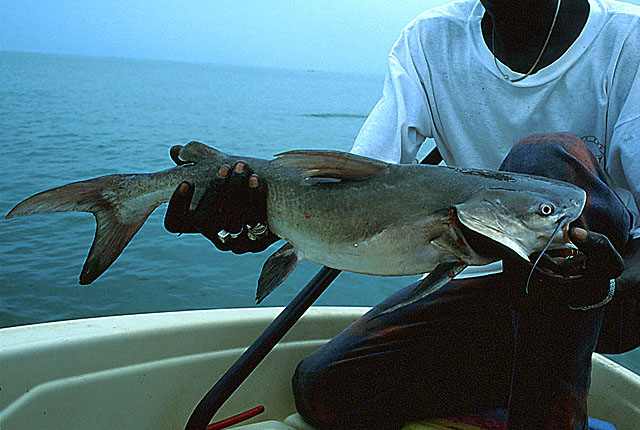| Ariidae (Sea catfishes), subfamily: Ariinae |
| 85 cm TL (male/unsexed) |
|
demersal; brackish; marine; depth range - 70 m |
| Eastern Atlantic: coastal waters from Senegal to Angola (Ref. 3546, 3876, 7367, 57224). One record from Fernando Poo (Ref. 6541, 89460). Also reported from various river estuaries. |
|
Dorsal spines (total): 1-1; Dorsal soft rays (total): 7-7; Anal spines: -0; Anal soft rays: 13-14. Diagnosis: body elongated and rounded, head broad and only slightly flattened above, snout rounded, mouth inferior; osseous head shield coarsely rugose, fairly visible through the skin; occipital process prominently broad at base, tapering posteriorly, with a median keel; predorsal plate very rugose, short and crescent-shaped; premaxillary teeth villiform, forming a plate slightly curved; palatine teeth in two pairs of patches, an anterior subquadrate pair and a posterior elongated pair, the anterior one wider and continuous with the posterior patch; no gill-rakers on posterior (inner) face of the first and second branchial arches; total number of anterior gill-rakers: on 1st arch 17-22, on 2nd arch 18-23 (Ref. 3546, 7367, 57224, 81640). Dorsal and pectoral fins with a strong serrated, erectile spine; adipose fin well developed (Ref. 57224, 81640).
Description: head slightly flattened and even
depressed with upper profile slightly
convex (Ref. 81640). Cephalic shield exposed, very rugose and anteriorly extending to level of eye; fleshy furrow of median depression of head also extending anteriorly almost to eye level; maxillary barbels reaching to pectoral fin base, mandibular barbels shorter, 5-6x as long as broad; gill rakers moderately long; dorsal and pectoral fins rays preceded by strongly ossified spine with denticulate anterior border in former and denticulate posterior border in latter fins; caudal fin deeply forked with long and pointed lobes (Ref. 3546, 7367, 81640).
Coloration: dark brown on dorsum, lighter on sides and whitish ventrally (Ref. 57224, 81640). Some specimens have lighter brown dorsum; in these specimens fins are light brown with distal part of dorsal, pectoral, pelvic, anal and caudal fins darker to blackish; barbels of these specimens are also whitish; some other specimens have dark dorsum and dorsal, pectoral, pelvic, anal and caudal fins are entirely black except for the anal fin base and median part of anal fin; barbels of these specimens are also partially or entirely black (Ref. 81640). |
| Mainly marine but frequently found in brackish estuaries, sometimes enters freshwater (Ref. 3876). Frequent in lagoons (Ref. 7367). Common during winter (Ref. 2683). Feeds on fish, benthic invertebrates, zooplankton and detritus (Ref. 28587). Wide range of diet including a high percentage of penaeid and other prawns, crabs, polychaetes, fish and molluscs (Ref. 57352, 81640). Eggs very few, spherical, very large (16-17 mm diameter); males practise buccal incubation (Ref. 57224) during which it seems the species continues to feed (Ref. 81640). Ornamental and sometimes considered aquaria fish (Ref. 27121), the fish is venomous and can be dangerous to humans (Ref. 12484). |
|
Least Concern (LC); Date assessed: 14 August 2019 Ref. (130435)
|
| venomous |
Source and more info: www.fishbase.org. For personal, classroom, and other internal use only. Not for publication.

